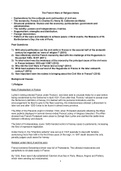Other
The French Wars of Religion Pre-U Paper 2b Early Modern European History Notes (Written by a D1 Student)
- Course
- Institution
In need of some help to smash your Pre-U exam on the French Wars of Religion? Then look no further! Written by a D1 student who later obtained a first in History from Oxford, these detailed notes can help you save time and obtain a better mark. The 19 pages of word-processed notes cover the f...
[Show more]



